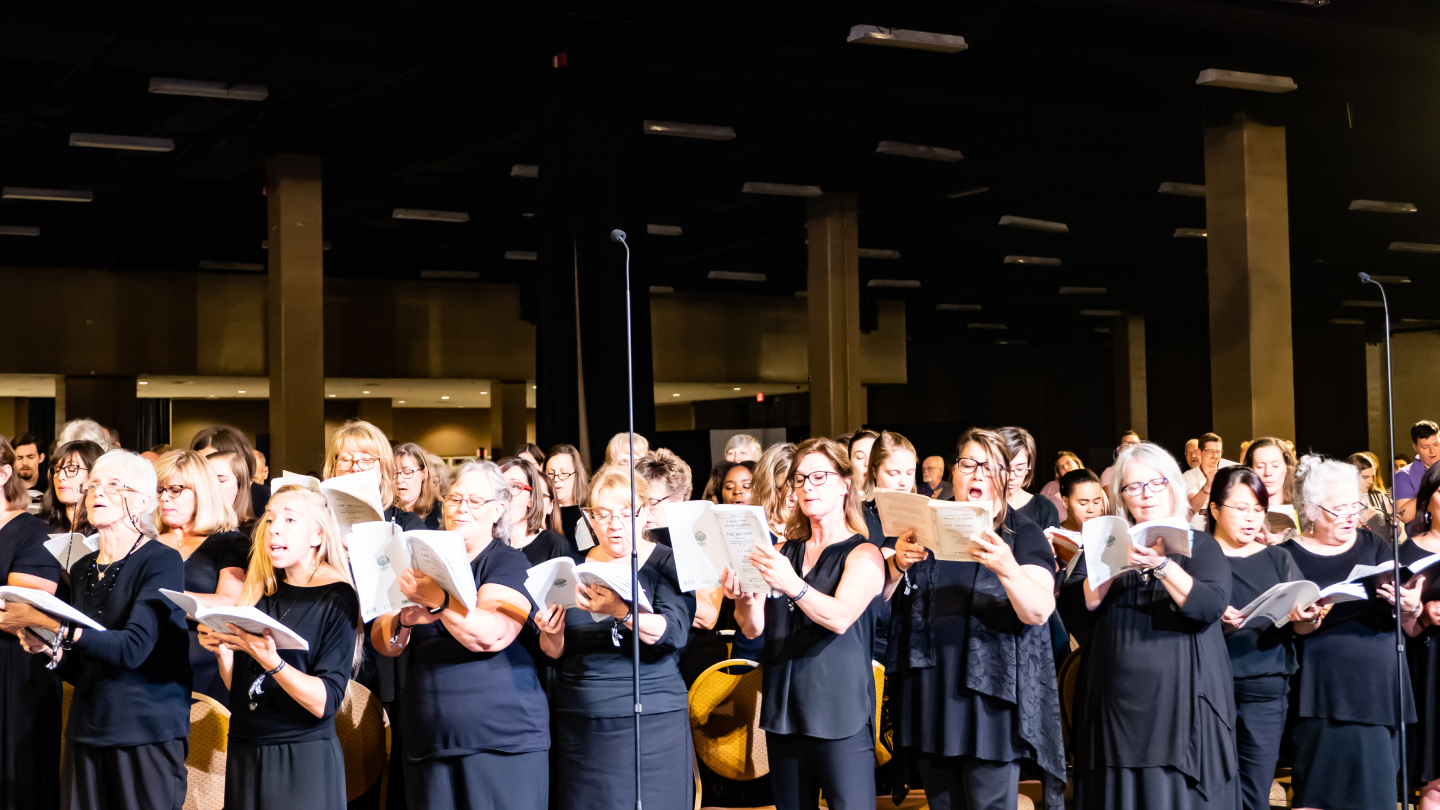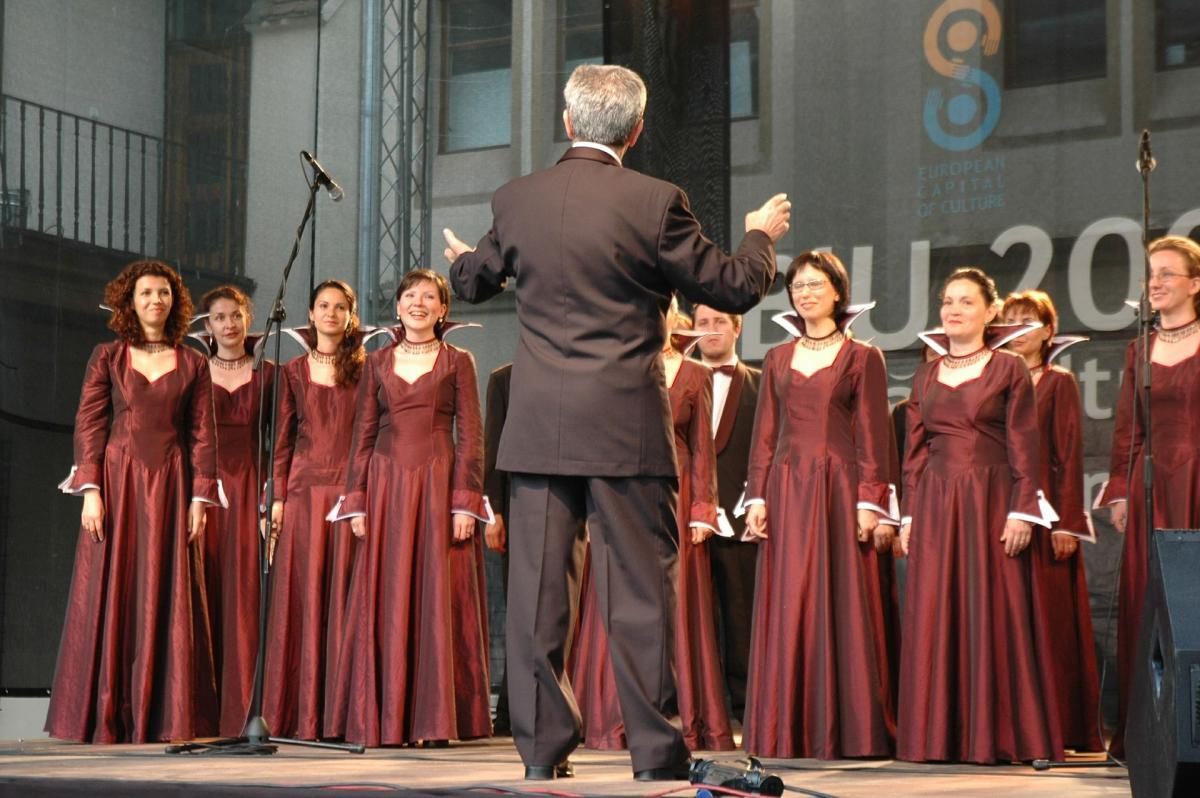Home>Production & Technology>Choir>How To Record Choir


Choir
How To Record Choir
Published: February 23, 2024
Learn how to record a choir with professional tips and techniques. Capture the beauty of choral music with our comprehensive guide.
(Many of the links in this article redirect to a specific reviewed product. Your purchase of these products through affiliate links helps to generate commission for AudioLover.com, at no extra cost. Learn more)
Table of Contents
Introduction
Recording a choir performance is a captivating endeavor that requires meticulous planning, technical finesse, and a deep appreciation for the art of choral music. Whether it's capturing the angelic voices of a children's choir or the powerful harmonies of a professional ensemble, the process of recording a choir demands careful attention to detail and a keen understanding of audio engineering.
In this comprehensive guide, we will delve into the intricacies of recording a choir, from selecting the right equipment to post-production editing. By the end of this journey, you will have gained valuable insights into the art and science of capturing the essence of a choir's performance in a recording.
The process of recording a choir is not merely a technical task; it is an art form in itself. It requires a delicate balance of technical expertise and an acute sensitivity to the nuances of choral music. Each voice in the choir contributes to the overall tapestry of sound, and the recording process aims to preserve and showcase the collective beauty of these voices.
As we embark on this exploration, it's essential to approach the recording process with a deep respect for the music and the performers. The goal is not just to capture sound, but to encapsulate the emotion, passion, and artistry that define a choir's performance. This requires a thoughtful and methodical approach, as well as a genuine appreciation for the music being recorded.
The journey of recording a choir is a multifaceted experience that encompasses technical expertise, artistic vision, and a profound understanding of the music being performed. It is a journey that rewards patience, precision, and a deep love for the art of choral music. So, let's embark on this enriching journey and unravel the intricacies of recording a choir in all its splendor.
Choosing the Right Equipment
Selecting the right equipment is paramount in ensuring a high-quality recording of a choir performance. The choice of microphones, recording devices, and other audio gear can significantly impact the final outcome. Here's a detailed look at the essential equipment needed for capturing the rich and intricate sound of a choir:
-
Microphones: When recording a choir, it's crucial to use high-quality microphones that can faithfully capture the nuances of multiple voices. Condenser microphones are often preferred for their sensitivity and ability to capture detailed sound. Large-diaphragm condenser microphones excel at capturing the full-bodied sound of a choir, while small-diaphragm condensers can capture the finer details and nuances of individual voices within the ensemble.
-
Microphone Stands and Mounts: Sturdy microphone stands and mounts are essential for positioning the microphones correctly. Adjustable boom stands provide flexibility in angling the microphones to capture the desired sound. Additionally, shock mounts can help isolate the microphones from unwanted vibrations and handling noise.
-
Audio Interface: A high-quality audio interface is necessary for connecting the microphones to a recording device or computer. The interface should have sufficient input channels to accommodate the number of microphones being used for the choir recording.
-
Headphones: Quality headphones are essential for monitoring the recording in real-time. Closed-back headphones are often preferred to minimize sound leakage and provide accurate monitoring of the recorded sound.
-
Recording Device or Computer: The choice between a dedicated recording device and a computer with audio interface depends on the specific requirements of the recording setup. Both options offer reliable recording capabilities, and the decision may hinge on factors such as portability and preferred recording software.
-
Cables and Accessories: High-quality XLR cables are essential for connecting the microphones to the audio interface. Additionally, pop filters can help reduce plosive sounds and sibilance, ensuring a cleaner recording.
Choosing the right equipment involves considering the acoustics of the recording space, the size of the choir, and the desired sonic characteristics. It's essential to assess the specific needs of the recording project and select equipment that can faithfully capture the choir's performance with clarity and fidelity. By investing in high-quality equipment and paying attention to the details, the recording process can elevate the choir's performance to new heights, preserving its artistry for generations to come.
Setting Up Microphones
Setting up microphones for a choir recording is a critical step that directly influences the quality and fidelity of the captured sound. Proper microphone placement and configuration are essential to ensure that each voice in the choir is accurately represented in the recording. Here's a detailed exploration of the key considerations and techniques involved in setting up microphones for a choir recording:
1. Understanding the Choir's Layout:
Before positioning the microphones, it's crucial to understand the layout of the choir. Factors such as the number of singers, the arrangement of vocal sections (sopranos, altos, tenors, and basses), and the overall spatial distribution of voices play a significant role in determining the microphone setup.
2. Selecting Microphone Types:
Different types of microphones can be used for capturing a choir, each with its unique characteristics. Large-diaphragm condenser microphones are commonly favored for their ability to capture the full-bodied sound of a choir, while small-diaphragm condensers excel at capturing detailed nuances and individual voices within the ensemble.
3. Positioning the Main Microphones:
The main microphones, often large-diaphragm condensers, are positioned to capture the overall sound of the choir. Placing these microphones in a spaced pair configuration, at a suitable distance from the choir, can help achieve a balanced and natural representation of the ensemble's sound. The aim is to capture the collective blend of voices while maintaining clarity and definition.
4. Adding Spot Microphones:
In larger choirs or acoustically challenging spaces, spot microphones can be strategically placed to capture specific vocal sections or individual voices. These spot microphones can provide additional flexibility during the mix and help in highlighting particular vocal nuances or sections within the choir.
5. Considering Room Acoustics:
The acoustics of the recording space significantly impact the microphone setup. It's essential to consider the reverberation and ambient characteristics of the room when positioning the microphones. Adjusting the microphone placement based on the room's acoustics can help capture a balanced and natural sound without excessive room reflections.
6. Test and Adjust:
Once the microphones are set up, conducting thorough sound checks and adjustments is crucial. This involves listening to the choir's performance through the microphones, making necessary positioning tweaks, and ensuring that the captured sound accurately represents the choir's dynamics and tonal balance.
7. Ensuring Phase Coherence:
When using multiple microphones, maintaining phase coherence is essential to prevent phase cancellation and ensure a cohesive sound. Careful attention to the relative distances and angles of the microphones can help preserve phase integrity and avoid sonic anomalies during the recording.
By meticulously setting up the microphones to capture the choir's performance, the recording process can faithfully preserve the artistry and emotive power of the ensemble's music. Each voice is given its rightful sonic space, and the collective harmony of the choir is captured with precision and depth, resulting in a recording that resonates with the true essence of the choral performance.
Positioning the Choir
Positioning the choir within the recording space is a crucial aspect of capturing a high-quality choir performance. The spatial arrangement of the singers not only influences the overall sound but also plays a pivotal role in facilitating an effective and balanced recording process. Here's a detailed exploration of the key considerations and techniques involved in positioning the choir for a recording:
-
Choir Formation: The layout of the choir, including the arrangement of vocal sections (sopranos, altos, tenors, and basses), significantly impacts the overall sound and blend of the ensemble. Depending on the size of the choir and the specific requirements of the recording, the singers may be arranged in a traditional formation, such as a semicircle or a more contemporary setup that complements the acoustics of the recording space.
-
Spatial Distribution: The spatial distribution of the choir within the recording space directly affects the stereo imaging and spatial characteristics of the recorded sound. Placing the choir at an optimal distance from the microphones helps achieve a balanced and immersive sonic experience. Additionally, considering the room acoustics and reverberation characteristics can contribute to capturing a natural and enveloping sound.
-
Balancing Vocal Sections: Ensuring a balanced distribution of vocal sections within the choir is essential for achieving a cohesive and harmonious sound. Proper positioning can help in balancing the prominence of each vocal section and contribute to a well-blended and unified choir sound. This may involve adjusting the spatial arrangement of singers to achieve an optimal vocal blend and tonal balance.
-
Interaction with Microphones: The positioning of the choir should take into account the interaction with the microphones. Ensuring that each vocal section and individual singer is adequately captured by the microphones requires thoughtful placement within the recording space. This may involve aligning the choir with the main and spot microphones to optimize the capture of the ensemble's collective sound while allowing for individual vocal nuances to shine through.
-
Rehearsal and Adjustment: Before commencing the recording, allowing time for the choir to rehearse within the designated positioning can facilitate adjustments and fine-tuning. This rehearsal phase enables the conductor and recording engineer to assess the spatial dynamics, tonal balance, and overall sound of the choir within the recording space, making any necessary adjustments to optimize the positioning for the recording.
By carefully considering the spatial arrangement and interaction of the choir within the recording space, the positioning process aims to create an environment where the choir's collective artistry and individual vocal contributions can be faithfully captured. The harmonious blend of voices, spatial depth, and sonic immersion are intricately woven into the positioning of the choir, laying the foundation for a captivating and evocative recording of the ensemble's performance.
Sound Check and Adjustments
Sound check and adjustments are critical phases in the choir recording process, marking the transition from preparation to the actual capture of the ensemble's performance. This pivotal stage involves meticulous scrutiny of the recorded sound, fine-tuning of audio settings, and ensuring that the technical elements align harmoniously with the artistic essence of the choir's music.
The sound check begins with a comprehensive assessment of the microphone signals, monitoring the choir's performance through the headphones or studio monitors. This real-time evaluation allows the recording engineer to gauge the tonal balance, dynamics, and overall sonic characteristics of the choir's sound as captured by the microphones. It serves as a crucial opportunity to detect any potential issues or anomalies in the recording setup, such as imbalances in vocal sections, unwanted ambient noise, or inconsistent microphone levels.
During the sound check, adjustments are made to optimize the microphone placement, input levels, and monitoring settings. Fine adjustments to the microphone positions may be necessary to ensure an even capture of the choir's sound, especially in larger ensembles where spatial dynamics play a significant role. Input levels are meticulously calibrated to prevent clipping or distortion while capturing the full dynamic range of the choir's performance.
Furthermore, the sound check phase encompasses the evaluation of room acoustics and reverberation characteristics. The recording engineer listens attentively to the captured sound, discerning the impact of the recording space on the choir's sonic portrayal. This critical assessment may prompt adjustments in microphone positioning or the application of acoustic treatments to mitigate undesirable room reflections and enhance the overall clarity of the recording.
In addition to technical adjustments, the sound check also provides an opportunity for the conductor and choir members to provide feedback on the monitored sound. This collaborative dialogue ensures that the captured sound aligns with the artistic vision of the performance, allowing for adjustments based on the ensemble's expressive nuances and tonal preferences.
Ultimately, the sound check and adjustments phase serves as the bridge between technical precision and artistic integrity. It signifies the convergence of technical expertise and musical sensitivity, where the pursuit of sonic excellence harmonizes with the expressive essence of the choir's performance. Through attentive sound checks and meticulous adjustments, the recording process endeavors to faithfully capture the emotive power, nuanced dynamics, and collective artistry of the choir, ensuring that the recorded sound resonates with the true essence of the ensemble's musical expression.
Recording Techniques
Recording a choir involves a delicate interplay of technical prowess and artistic finesse, where the application of specific recording techniques becomes paramount in capturing the full breadth and depth of the ensemble's performance. Here, we delve into the nuanced realm of recording techniques, unveiling the methodologies and approaches that contribute to the creation of a captivating and sonically rich choir recording.
1. Stereo Miking Configuration:
Employing a stereo miking configuration, such as the widely utilized X/Y or ORTF technique, can imbue the choir recording with spatial depth and immersive sonic imagery. By strategically placing a pair of microphones to capture the ensemble's sound in a stereo field, the recording achieves a sense of dimensionality and realism, faithfully representing the choir's spatial dynamics and tonal balance.
2. Ambience and Room Miking:
Integrating ambient and room miking techniques allows for the capture of the choir within the context of the recording space. By utilizing additional microphones strategically positioned to capture the reverberant characteristics and natural ambience of the room, the recording acquires a sense of envelopment and acoustic authenticity, enhancing the sonic portrayal of the choir's performance.
3. Close Miking for Detail:
Incorporating close miking techniques for individual vocal sections or soloists within the choir enables the capture of intricate vocal nuances and emotive subtleties. By placing microphones in close proximity to specific vocal sections, the recording attains a heightened level of detail and intimacy, allowing for the preservation of individual vocal expressions within the ensemble's collective sound.
4. Dynamic Microphone Techniques:
Integrating dynamic microphone techniques, particularly for capturing the powerful resonance of lower vocal registers or amplifying the percussive elements within the choir's performance, adds a layer of sonic impact and energy to the recording. Dynamic microphones excel in capturing robust and impactful sound sources, contributing to the overall sonic character and tonal richness of the choir recording.
5. Multi-track Recording for Flexibility:
Opting for a multi-track recording approach provides the flexibility to capture individual vocal sections and soloists on separate tracks, offering enhanced control during the mixing and post-production stages. This method allows for precise adjustments, vocal balancing, and the application of tailored processing to each recorded element, culminating in a cohesive and polished choir recording.
6. Vocal Section Blending:
Employing meticulous vocal section blending techniques during the recording process ensures a harmonious and unified sonic portrayal of the choir. By meticulously balancing the vocal sections and adjusting microphone levels to achieve a cohesive blend, the recording captures the ensemble's collective synergy and tonal cohesion, resulting in a balanced and immersive sonic tapestry.
7. Real-time Monitoring and Artistic Direction:
Utilizing real-time monitoring during the recording process enables the conductor and recording engineer to provide immediate artistic direction and feedback to the choir. This collaborative approach allows for adjustments in dynamics, phrasing, and expressive nuances, ensuring that the recorded performance aligns with the ensemble's artistic vision and emotive intent.
By embracing these recording techniques with precision and artistry, the choir recording transcends mere audio documentation, evolving into a captivating sonic narrative that encapsulates the essence, emotion, and artistry of the ensemble's musical expression. Each technique serves as a brushstroke in the canvas of the choir recording, contributing to a vivid and evocative sonic portrayal that resonates with the true spirit of the choir's performance.
Post-Production and Editing
Post-production and editing constitute the transformative phase where the raw choir recordings are meticulously refined, polished, and sculpted into a cohesive and sonically captivating musical presentation. This pivotal stage encompasses a myriad of creative and technical processes that elevate the recorded choir performance into a compelling and immersive sonic experience.
The post-production journey commences with the transfer of the recorded audio tracks into a digital audio workstation (DAW), where the intricate process of editing, mixing, and mastering unfolds. Here, the recording engineer assumes the role of a sonic sculptor, wielding a palette of tools and techniques to shape the raw audio into a refined and emotive musical narrative.
Editing involves the meticulous arrangement and alignment of vocal tracks, ensuring seamless transitions and precise synchronization of the choir's performance. Any imperfections or inconsistencies are meticulously addressed, allowing for a cohesive and polished sonic portrayal of the ensemble's artistry.
The mixing process is a symphonic dance of sonic elements, where each vocal section, soloist, and ambient texture is delicately balanced, panned, and sculpted within the sonic landscape. Through the application of equalization, dynamic processing, and spatial enhancement, the recording engineer weaves a tapestry of sound that amplifies the emotional depth and expressive nuances of the choir's performance.
Mastering, the final stage of post-production, bestows the recording with sonic finesse and cohesion. It involves the refinement of the overall sonic character, application of subtle tonal enhancements, and the integration of final touches that elevate the recording to its full sonic potential. The mastering engineer delicately shapes the tonal balance, dynamics, and spatial depth, ensuring that the recorded choir performance radiates with clarity, warmth, and sonic richness.
Throughout the post-production and editing process, a profound reverence for the artistry of the choir's performance permeates each decision and adjustment. The recording engineer's role extends beyond technical proficiency, embracing a deep understanding of the expressive nuances, emotive intent, and artistic vision of the ensemble. Every edit, mix adjustment, and sonic enhancement is guided by an unwavering commitment to preserving the emotive power and artistic integrity of the choir's performance.
In essence, post-production and editing constitute the alchemical process where the raw essence of the choir's performance is transmuted into a captivating sonic masterpiece. It is a testament to the dedication, artistry, and technical finesse that converge to immortalize the choir's music in a recording that resonates with the true essence of the ensemble's musical expression.
Conclusion
The journey of recording a choir is an artful fusion of technical precision, artistic sensitivity, and a deep reverence for the emotive power of choral music. As we conclude this comprehensive exploration, it becomes evident that the process of capturing a choir's performance extends far beyond the realm of audio engineering; it is a testament to the profound human connection and collective artistry inherent in choral music.
The meticulous attention to detail in choosing the right equipment, setting up microphones, positioning the choir, conducting sound checks, and applying recording techniques serves as a testament to the dedication and expertise required to faithfully capture the essence of a choir's performance. Each phase of the recording process is imbued with a sense of reverence for the artistry of the ensemble, aiming to preserve and amplify the emotive nuances, harmonious blend, and expressive depth of the choir's music.
Moreover, the post-production and editing phase emerges as a transformative journey, where the raw audio recordings are sculpted into a cohesive and sonically captivating musical narrative. The delicate balance between technical refinement and artistic interpretation culminates in a recording that transcends mere documentation, evolving into a captivating sonic portrayal that resonates with the true spirit of the choir's performance.
Ultimately, the conclusion of the recording journey signifies the culmination of a collaborative endeavor to immortalize the choir's music in a timeless and evocative sonic form. It is a celebration of the collective artistry, emotive power, and enduring legacy of choral music, encapsulated in a recording that reverberates with the passion, harmony, and profound human connection intrinsic to the choir's performance.
As we reflect on the enriching journey of recording a choir, it becomes apparent that the process is not merely a technical undertaking; it is a profound homage to the transcendent beauty and emotive resonance of choral music. The recorded sound becomes a vessel that encapsulates the timeless essence of the ensemble's artistry, preserving it for generations to come and perpetuating the transformative power of choral music.
In essence, the conclusion of the choir recording journey marks the beginning of a new chapter, where the recorded sound becomes a testament to the enduring legacy and profound impact of choral music, perpetuating its emotive resonance and captivating allure for audiences far and wide.











